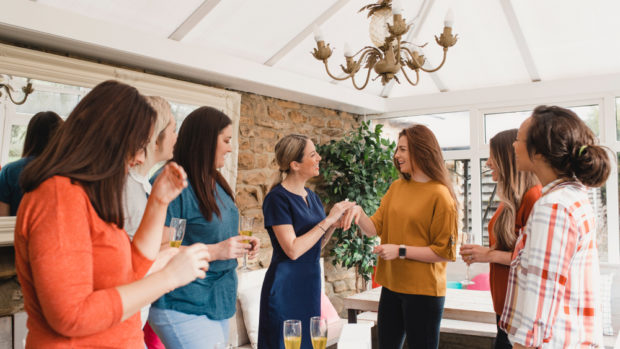
Entrepreneur and self-confessed “foodie”, Daniel O’Neill, founded ProCook, the UK’s leading direct-to-consumer specialist kitchenware brand, from his Cotswold home in Gloucestershire 26 years ago.
Now with 53 stores UK wide and a strong online presence, ProCook has not only weathered the Covid storm, but has positively thrived. Profits are set to top £10 million this financial year on a turnover of more than £50 million with profits having increased by 40 per cent year on year in the last quarter. Having floated ProCook on the Main Market of the London Stock Exchange this November with a valuation of £158m and as a multiple Direct Commerce award winner, Daniel shares some of the secrets of his success.
Q: How and why does someone with a background in software development create a cookware empire?
As a family, food has always been a big thing and this became more so when we were in our twenties. My brother and I left home quite young and for us our love of food was always around Sunday lunch which became a bit competitive! I wrote software for about 7 or 8 years but when I decided to do something together with my brother and my mum, Peggy, it seemed natural to pivot around food and it became an obvious choice. I still enjoy cooking now and have recently been to our ProCook Cookery School (In Tottenham Court Road, London) to learn how to make tapas and paella and lots of other lovely dishes, so yes, I love to cook!
Q: How did it all start?
We started off in Mail Order and our very first retail launch was within the BBC Good Food Magazine, where we placed a single page advert. The offer was a 12-piece stainless steel cookware set which we sold for £199 in four easy instalments, and generated £77,000 from the one advert, so it was an immediate success.
Q: So you then moved into shops – what is the actual proposition?
We don’t mind where somebody buys from us. The important thing is that they buy it direct from us. We like to know our customers, so even in-store we collect almost 70 per cent of emails from people who purchase in our stores, and obviously 100 per cent from those that buy from us online.
Knowing your customer is key, and that is a reflection of our mail order background – it’s always been in our DNA! We started off in the mid-90s in Mail Order. Then by 1999 we opened our first store in Mansfield which was very successful. We have just opened our most recent store in Cribbs Causeway this October, and we are opening shops at Westfield London and Westfield Stratford in December taking our store count up to 55. We have ambitions to increase our estate in the UK to around 70 stores.
Q: Is there an entry level that people come in on and then how do you manage that customer journey to cross-sell and upsell to give a better lifetime value?
From a price point of view, we have very different average transaction values. Typically, it is over £70 on the website and just over £30 in-store, and when we open a new store that average price is closer to £80. If you buy a cookware set from, say £100 to upwards of £600, it is quite a considered purchase, so we find that the longer we know someone; the longer a shop is open, the ALV will lift accordingly. Online, the sweet spot for initial purchase is no different to everyone else’s, products under £100. We do mix it up – we may sell a knife for under £20 which tends to get really high engagement, for that second purchase.
If people purchase a smaller cookware range, we can sell them a matching lovely wok or sauté pan, so it is very easy for people to add to their set and keep growing the same range.
At the conference, Nigel Swabey highlighted the important role that a catalogue can still play within the marketing mix
The catalogue, I completely get – we offer everybody who comes and buys from us a catalogue. I still think that with more time at home there is a place for catalogues, they are very valid today. You have got to give people a choice. It’s important to be omnichannel and sell everywhere and that includes offering a catalogue option.
Q: With online sales accounting for over 50 per cent of sales, how do you drive traffic online and engage with prospects and what email marketing do you do to drive people into store or online?
In terms of how we segment, for quite a long while we just kept to the one big segment which worked really well for us as one large group, but we have started to look at this a bit more carefully and move it forward. We now have retail and web split separately, categorised by when we recruited them, which has definitely helped. The retail emails now target just those retail customers, and we email those less because people would only tend to visit one of our stores at most 2 or 3 times a year, so emailing them lots and lots didn’t really make sense. The content will also differ in terms of what’s going on – it’s a bit more personal.
Q: Do you use influencers within your marketing mix?
Yes, we do use them a little bit and it is an interesting field. It’s quite a tightrope trying to get the right one but worth exploring. If you’re looking for cookware Google will find you, but interrupting people’s social time on mobile or tablet, that is where we have to get to – rather than reacting to them, we should create a proactive approach.
Q: What tips for keeping customers engaged on your website?
Keep it simple and appreciate what your audience is expecting to see.
Q: How did Brexit and the Pandemic impact on your sales and stock management?
You create luck don’t you. When the shops closed and people wanted to update and replace their kitchenware, a lot of places ran out of stock and couldn’t get anymore very quickly. We were very fortunate as up to that point about 60/65 per cent of our sales came from retail, so when the stores closed and everyone tried to buy online we had a significant amount of stock that we were able to divert from retail to our eCommerce side.
An added advantage was that, as we all know how Google works, we kept converting those sales and our ranking with Google kept growing. We took the decision that when the shops reopened, it wouldn’t all migrate back, and we would continue with strong web trading. We re-ordered assuming that we would hit that growth number, which was, at the time, a brave decision because we could have been quite heavily over-stocked, but it worked out ok. As stores reopened, they bounced back and the rankings we achieved with Google stayed, and it looks like it’s going to be up on last year.
Q: How are you addressing the need for sustainability and local sourcing?
We always look at ways to be sustainable. We are trying to eradicate the use of single-use packaging which we have taken out of 90 per cent of our product packaging. We are very passionate about making sure we do our bit, such as minimising the print runs in what we produce and looking to offset carbon emissions. We have tried to source in the UK where we can, and we have been successful with a couple of things, but often with the volumes we require it simply isn’t possible.
We are working with a partner in Europe and we are shipping from the UK so it involves double the mileage but we are hoping to start shipping direct from the suppliers into Europe rather than in from the UK.
Q: With the benefit of hindsight what tips would you share?
When we started, one of our competitors was Steamer Trading who we then acquired at the start of 2019. They had a successful model, selling other people’s brands and we were trying to build our own brand. As the internet grew, so did the ability for people to shop around, for branded purchases either online or in stores. This, unfortunately, became the demise of Steamer Trading. We did try and rescue it and focused on the ‘best of brands’ but people have become very savvy shoppers, and will literally walk into a shop and scan the code of a product and find out what price they can buy it for.
So, my advice is that whilst it might be harder to start with, and the reason why ProCook has got to where it is today, is to be a brand that is sold direct to the consumer that can’t be purchased elsewhere. We control every aspect of the operation, from the price point and how it is presented. Our ability to launch is so much tighter than being manufacture reliant- don’t be dependent on anyone else, be your own brand.
Q: What is your favourite product?
We introduced a range of Damascus Japanese stainless-steel knives at the start of 2021 called Damascus 67, and they have sold really well. We designed everything to do with it and took it to the n’th degree – the block they sit in is beautiful. I am very lucky that I am able to design beautiful products and bring them to market.
Q: Who do you see as your competitors?
The biggest is Amazon which is probably everybody’s competitor. John Lewis is incredibly strong, and Lakeland, although they seem to do more homeware than us, we focus on kitchenware. Plus, all the new kids on the block we have to look out for that are active on Instagram and Facebook.
Q: What are your plans for the future?
We’ve just floated on the London Stock Exchange which is exciting, offering a wider share option with our team. We will open a few more stores and increase our brand awareness. Omnichannel works well and we see a peak of online sales where we have stores. Range extensions plus tableware- a relatively new category for us but is doing really well.
We plan to launch into Germany, at the back end of this year/ early next year, taking our story to Netherlands, Germany and then on to France.
Q: Final nuggets of wisdom?
To be successful pick something that you really enjoy otherwise it becomes a chore. If you’re passionate about what you do, and you work with passionate people and get the right ones, it helps massively.
by Claire Hart, Associate Contributor, Direct Commerce Magazine








Share